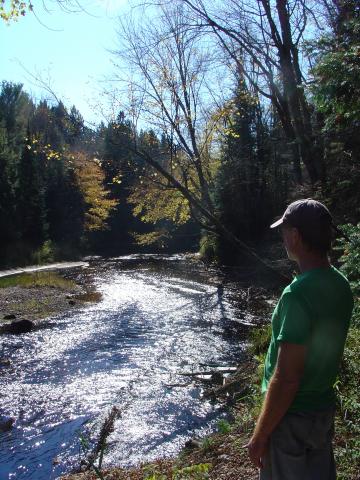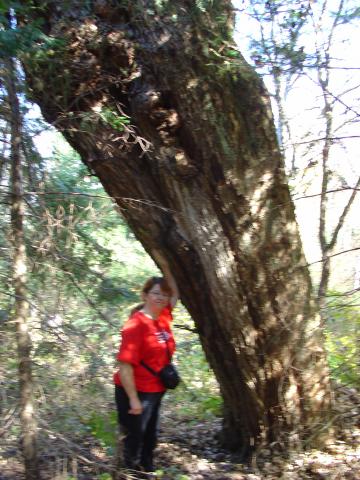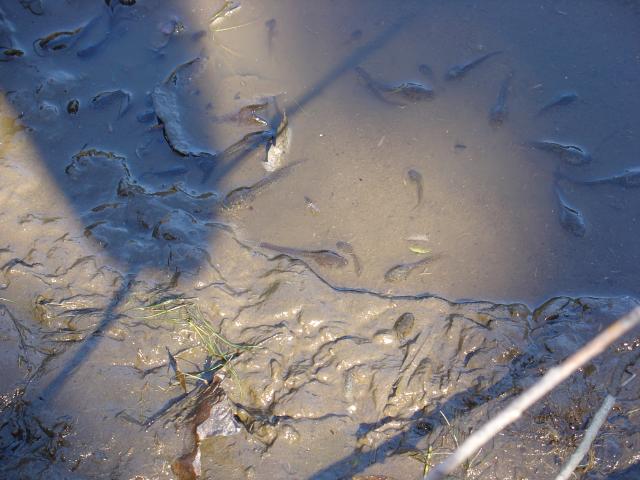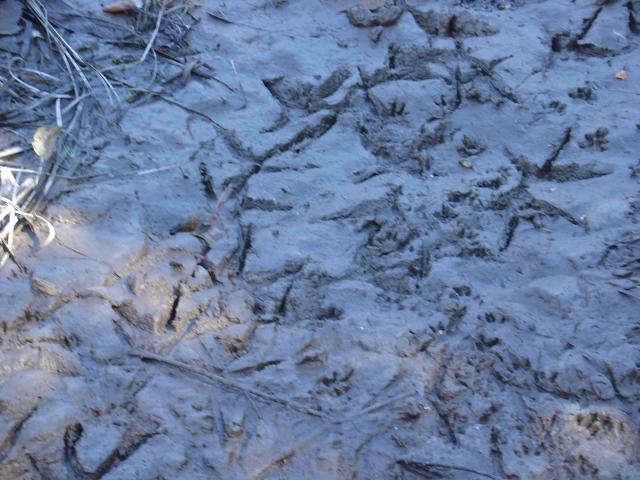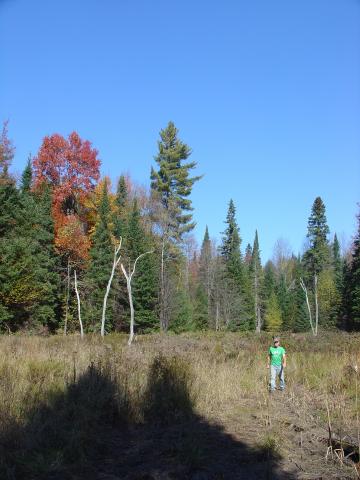June 2, 2010
Just returned from another glorious visit to the Black River in Bracebridge ("the bog") ....
.... and many wildflower species are now coming up everywhere, with the Evening Primroses looking poised to exceed last year's stands. Shorter varieties such as Orange and Yellow Hawkweed, Cat's Ear and Red Clover were already in bloom and establishing themselves, making it possible to see just where to cut the surrounding grasses to optimize the flower growth in my Muskoka lawn. Armed with a scythe, clippers, a rake and my NaturCut Classic HD, I proceeded to tend my large yard. The going was very rough and thick, but after a couple hours I had cut a lot of grass "carbon-neutral style".
And while blackflies may have mostly played themselves out in Muskoka, the mosquitoes certainly had not. As in other years, I was truly amazed to see dozens of dragonflies appear "out of nowhere" and patrol my work area for biting bugs, making the hot and humid day much more productive and enjoyable for me.
Because of the warm, drought-like conditions this Spring, I applied a quantity of well water to my new apple trees and prayed that the forecasted rain would come. In fact, the thunder and lightening rolled in just as darkness fell that night. What made this an amazing experience was the sudden appearance of fireflies. These incredible insects are usually best viewed in July, but here I was on the last day of May seeing scores of them seemingly activated by the early combination of heat, humidity and lightening!
Frog Bog Blog....
... my nature diary
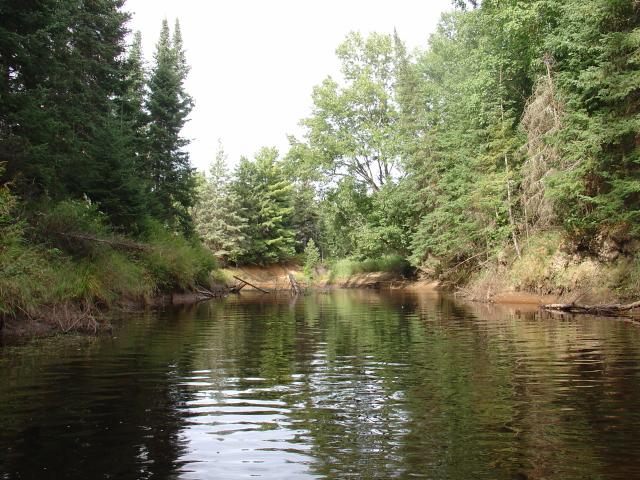
June 17, 2010
Another visit to the Black River. In spite of the cooler nights (down as low as 10 degrees Celsius with warm days in the forecast), the fireflies were still putting on a pretty respectable display. Once again, there is a groundhog living under the metal shed, virtually in the shadow of an active hawk's nest. As usual, there were fresh moose prints in the lower yard and many other things of interest.
I was very happy to see that the small "bullrush garden" near the cabin had not gone dry and it rained most of yesterday to top things up a bit. The shallow pools were full of duckweed with green frogs poking their heads above the surface to bask in the warm sun.
White Admiral butterflies were drifting through the yard, attracted to the new white raspberry blossoms, and the thick grasses were now full of grasshoppers and many other summertime bugs. Of course, I took advantage of the fine weather and trimmed the lawn with my NaturCut Classic. One environmental advantage of push reel mowers is the gentle way in which they cut which allows the operator to avoid "collateral damage" to fauna such as insects and toads.
I took the back roads through Housey's Rapids on my return trip to the city and stopped my car for a medium-sized Painted Turtle who was sunning in the middle of Doe Lake Road. It seems that I encounter turtles on these roads quite often, though usually they are Snappers. The best practice to help these reptiles when they are vulnerable on the road is to carefully pick them up and move them across in the same direction that they were pointed. In this case it was a simple matter because it was a docile Painted and, as a bonus, there was a nice pond right beside the roadway in front of the turtle. When I move Snappers off the road it can be much more exciting .... I always wear gloves and make sure that I grasp the shell well back from the head. Never underestimate the length of a Snapping Turtle's neck! None the less, even the hind feet of a large Snapper can be quite the handful.
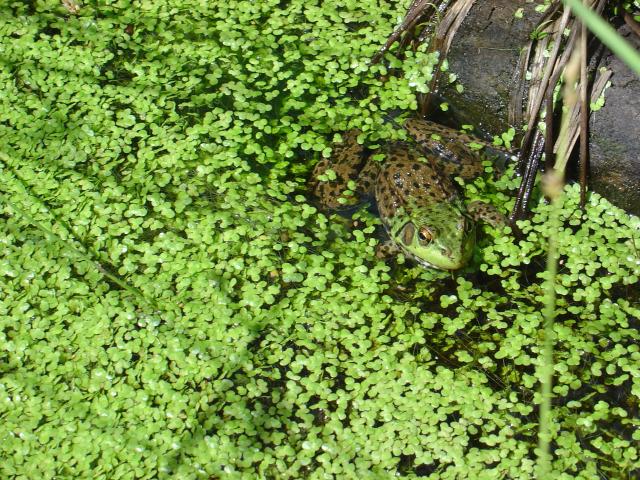
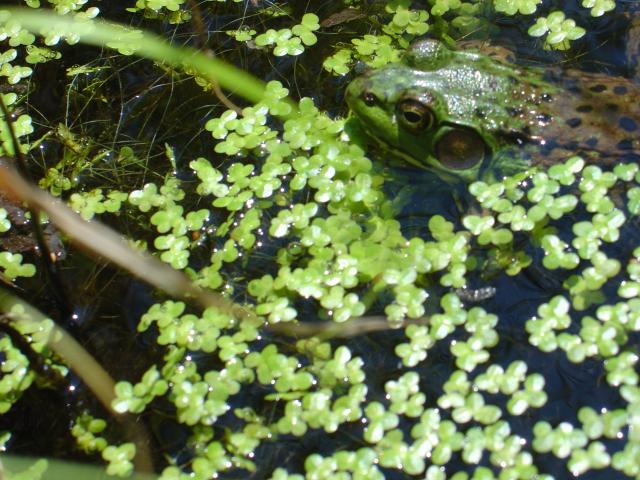

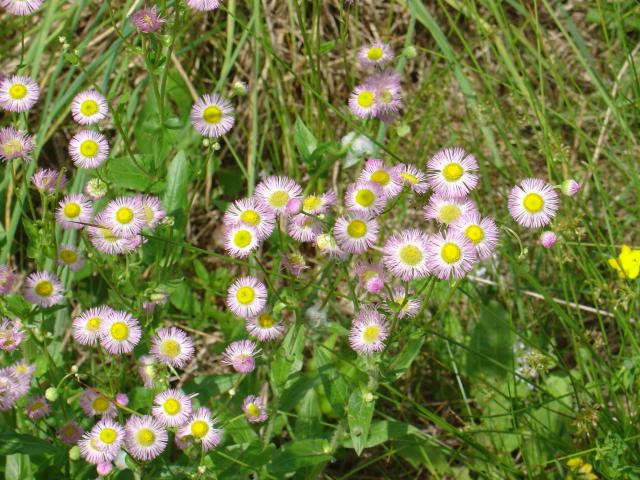


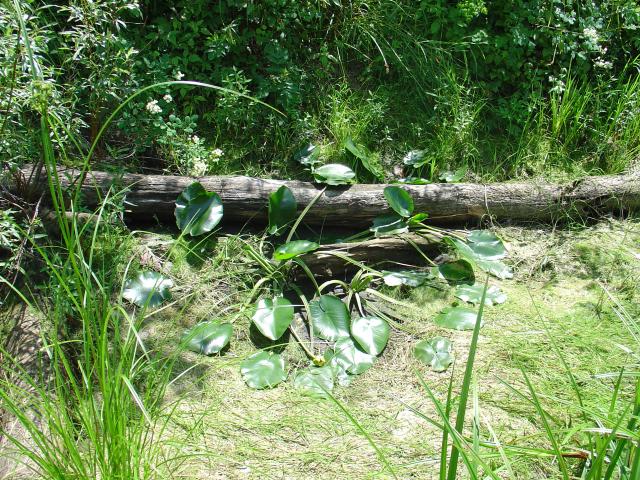
July 20, 2010
Now that the Summer rains have started to come, Mother Nature is making up for time lost during the dry Spring. As the above photo shows, small vernal pools that would normally still contain water had gone temporarily dry in many places. The good news? Fewer mosquitoes! Not so good is the fact that this pool is usually home to a number of Leopard and Green Frogs that will have migrated to the stream and river areas in search of moist habitat. In a wet year, it is not unusual to see these frogs up in the yard and around the cabin. Increased habitat competition in wetlands will obviously factor into the population dynamics of amphibians.
The lack of Spring rains has also reduced the number of Evening Primrose blooms in our yard, although they are now trying to catch up. One sunny morning I went outside to find all of the available flowers full of breeding Rosy Maple Moths (photos to left). These pretty moths frolicked for a few days and then became scarce. With moths and butterflies, it seems that there is always a new species or two waiting in the wings to take over -- a few days ago the Monarch Butterflies and Painted Ladies were steadily increasing in number.
Violent thunderstorms and high winds have also resulted in a number of downed trees. I take advantage of this fresh "dead fall" to harvest maple, cherry wood and ash for the wood stove in winter. There are always enough downed trees on our property to make the harvesting of healthy trees unnecessary.
Rabbit and other small mammal populations seem to be up from last year, with daily activity in the yard. Unfortunately, we also have had some mouse visitors inside the cabin. On a brighter note, the Red Squirrels and Chipmunks are plentiful this year and they are always engaging to watch as they "steal" nuts from right under our noses.

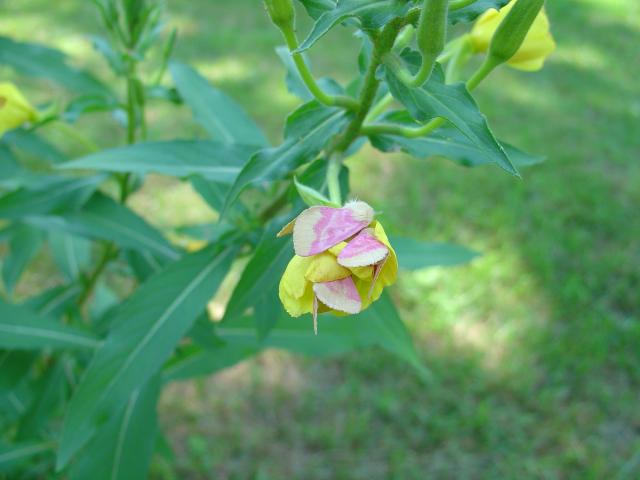
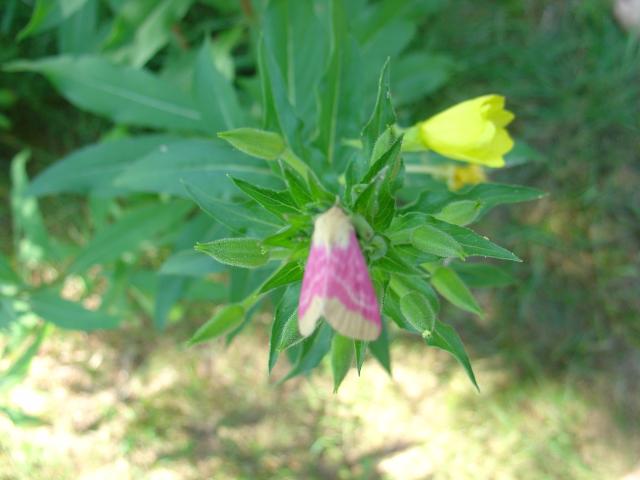

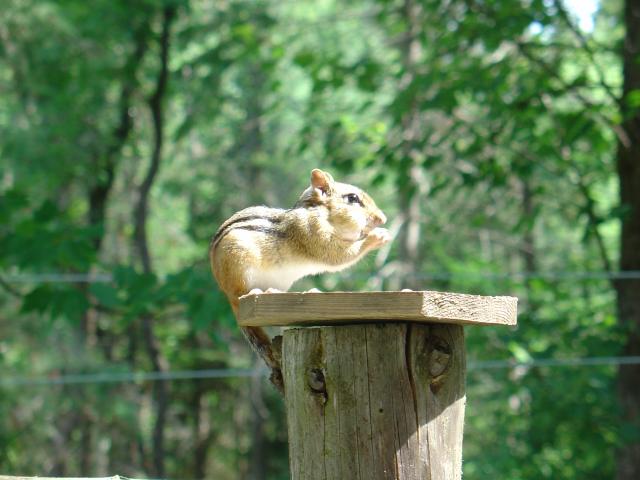
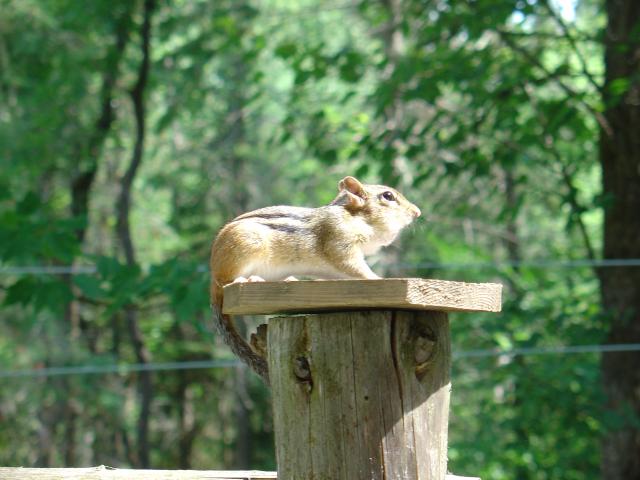
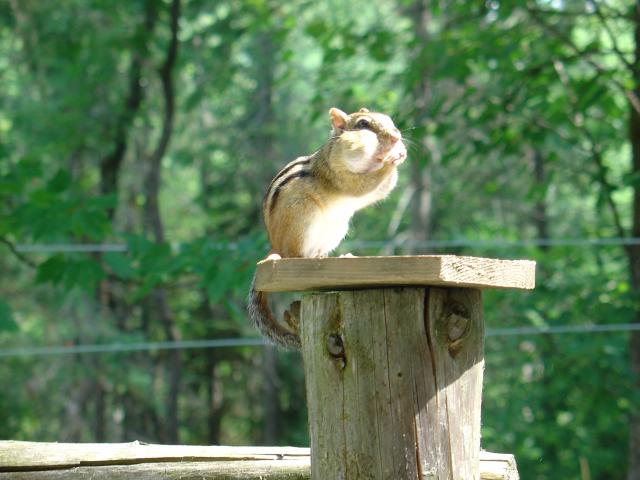
July 26, 2010
A quick one-night visit to the bog was not a disappointment. I arrived at about 4:00 p.m. on Sunday and was amazed at the number of Blue Jays in the trees around the cabin. During the winter people in the area had commented on how few of these birds they were seeing, but now there were dozens of them calling from the branches. Just another wonderful moment in the even changing natural landscape!
It was a clear night with a full moon and the high humidity had broken that day. I awoke the next morning to bright sunshine and birds chirping. The hum of countless insects was pulsating off of the meadow and there were Goldfinches and other songbirds in the yard. I decided to go for a short walk and was very happy to see that there were numerous small Leopard Frogs all about the yard, undoubtedly encouraged by recent rainfall. Much to my surprise, I saw a Gray Tree Frog on the ground (photos below). Interestingly, this little fellow had snuggled into a fresh moose print where moisture had collected and seemed to be enjoying the sunshine too. The Gray Tree Frog has the ability to change colour as can be seen by the lovely green tone of this specimen. Later in the day I also saw a tiny Spring Pepper (another species of tree frog) that simply vanished into the long grass. While it is common to hear these tree frogs chorusing in April and May, they are generally so small and well camouflaged that they are easily missed by the eye.
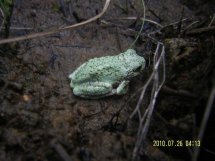
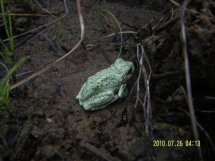
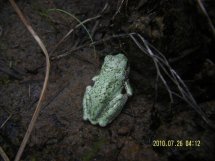
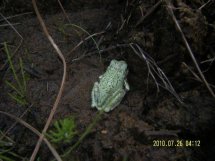
August 9, 2010 --- The Importance of Urban Green Spaces
It was another muggy Toronto evening as I walked through "The Quarry" green space just west of Warden Ave. between Gerrard and the railway tracks that run south of Danforth Ave. The heavy blanket of grass and weeds was still wet from the rain so I stuck mostly to the main path. It seemed strange that the path was full of snails, but I did my best not to step on them. It was as if they had suddenly just appeared out of nowhere.
Cicadas were whining from the trees as a lone cardinal called. Swallows swooped low in the air above my head acrobatically snatching flying insects. I spotted a gentle brown snake coiled on the path in front of me -- it quickly slithered away. I smiled to myself. These were all positive signs showing the importance of our green spaces to urban biodiversity.
Currently, there is strong local opposition to the imminent development of this 49 acre site. The plan is to build a number of high-density residential buildings in the green space. Homeowners in the area are complaining that the zoning which allows this development is no longer current because it has not been reviewed since the 1960's. If you Google search "Birchcliff Quarry" you will find numerous items published about this: everything from the official City of Toronto site to a protest video posted on YouTube.
August 11, 2010
Many might consider this to be too much "urban wilderness":
A little after 9:00 p.m. my neighbour and I watched a cocky coyote wander straight up our street at nightfall. The neighbourhood dogs could sense the difference in the air and there was much barking to be heard from several yards. While it is easy to see this animal as "vermin", the other side of the coin tells us that the small predator would not be here unless there was adequate prey. I have also spotted red foxes at night in the Birchcliff and Beaches areas. No doubt these animals contribute to the control of urban rodent populations.
-August 16, 2010
Last night we drove up to the Black River through torrential rain. Doriann did a great job of avoiding the frogs that were swarming Highway 118 East -- they were hopping around on the wet pavement by the dozens as we drove past Vankoughnet. Today the weather is sunny and pleasant. Not surprisingly, Leopard Frogs are still plentiful in the lawns surrounding the cabin, hidden in the grass (above photos). Small groups of Monarch Butterflies are passing through the mature meadows now and I saw a number of Ruffed Grouse out in the bush. The next morning I went for a walk and encountered a spunky pair of Marsh Wrens down by the river. The August rains have topped up the Black River nicely, making it easier to navigate by canoe. Later in the day, I startled a Woodcock at the edge of the forest. Large and long-billed, this bird can be quite the character as he circles the yard making loud calls during the Spring mating season. With the height of Summer now upon us, he was just out enjoying the early evening and a bit of leisurely grub foraging.
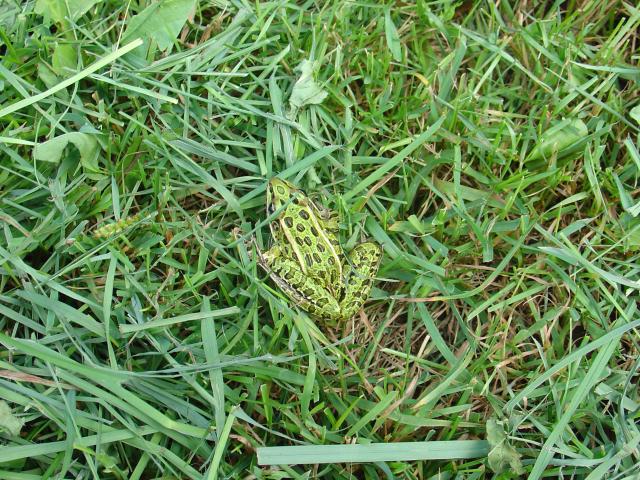

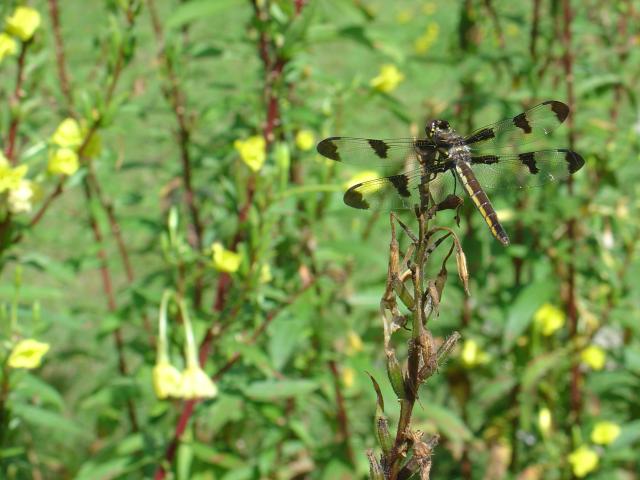
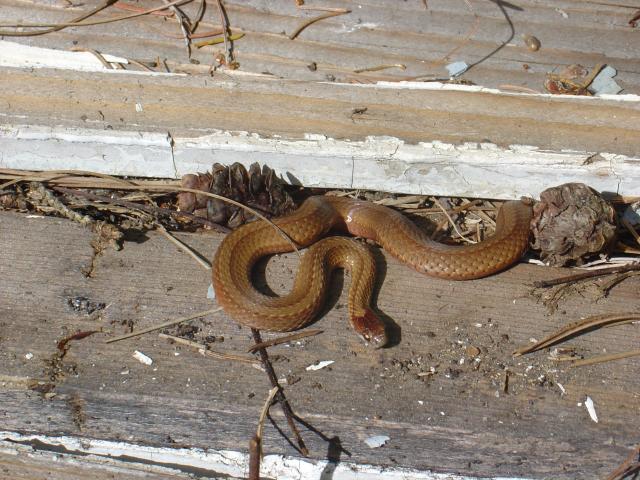
SPRING/SUMMER 2010
September 12, 2010
The past few days just flew by at the Black River and now I'll be lucky to get back up there before Autumn. It was a glorious Summer, lush and brimming with natural wonder in spite of a dry and tentative Spring. On the bog, vernal pools that were oddly dry in the Spring and early Summer are now topped up and full of life. The water level in the river is also higher than at a typical Summer's end.
The naturalization of my lower yard continued and made great headway with a number of wildflower species taking hold along with some young evergreen and poplar trees. Certain species of animals seemed to increase in number dramatically including frogs (especially Leopards), Brown Snakes, Blue Jays, and butterflies (Red Admirals were especially plentiful in the early Summer). There were definitely less black flies and mosquitoes this year, but the deer flies were fierce earlier on. Dragonflies were still plentiful but the gorgeous jewel damselflies were down a bit from last year, most noticeably along the river. Judging from their spoor, it seemed that larger animals such as deer and moose were having an average-to-good year, but there was less evidence of black bears in our immediate area. A bumper crop of small mammals, especially mice, has helped to increase the sightings of hawks and other raptors and it is not uncommon to hear a barred owl calling at night. All in all, a great year for hiking and canoeing.
Doriann and I threw the Royal-X canoe in for a late summer trip down the river yesterday. It had become a warm and sunny afternoon and we enjoyed taking our time. In a marshy river-bend just west of Thompson Road we startled a blue heron that was fishing in the reeds at the mouth of a small tributary stream. It was magnificent to watch as it flew away, traveling upstream into the wilderness.





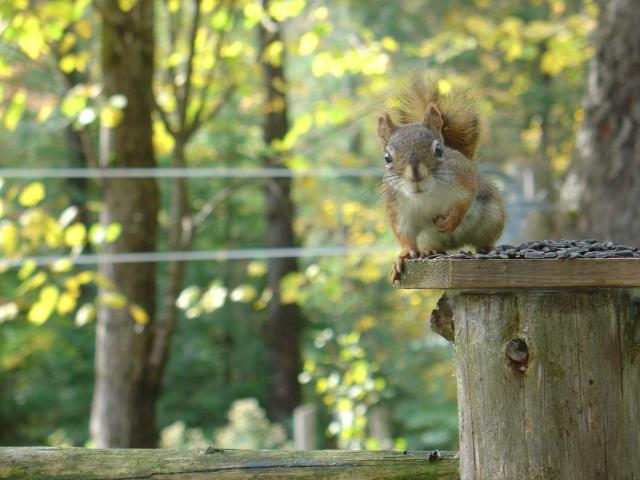
FALL/WINTER 2010/11

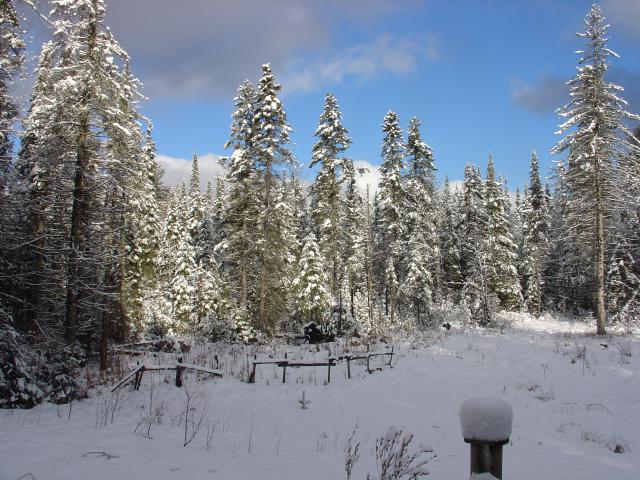
When the leaves are off the hardwood trees and the sap has mostly run out, my thoughts turn to firewood. I built this airy wood shed (above) for fast and mold-free curing. The shed ventilates freely from the top, bottom and sides for best results. Burning hardwood that has been properly dried helps to decrease the carbon footprint, as does transporting it in from the woods by wheelbarrow. It also makes good environmental sense to harvest fresh dead fall (trees that have recently fallen down and would otherwise rot). The shed is sturdy, features sliding doors and is made almost entirely of salvaged materials -- "reduce, re-use, recycle".
The photo below left is the view off our deck in early December. The lighting was interesting, sunny with dark storm clouds passing by all day long. Below right shows a bend in the Black River covered with a blanket of snow.
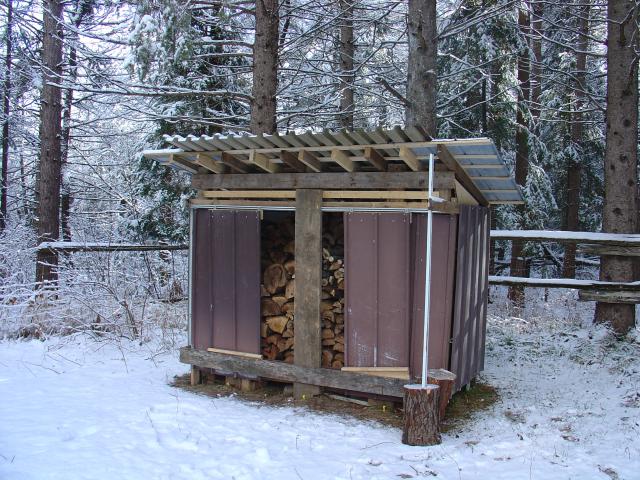
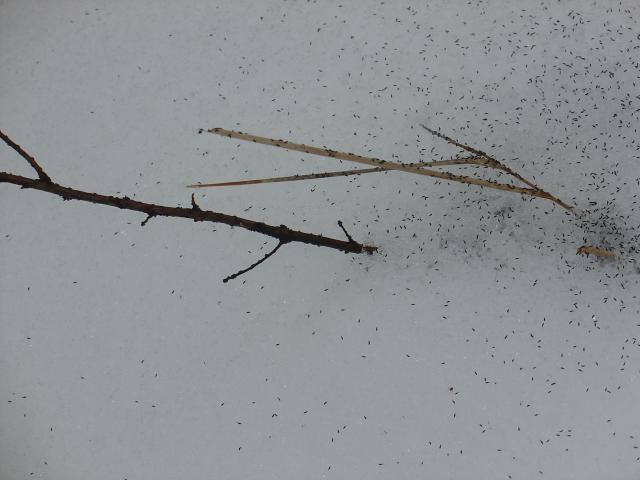

A hike on snowshoes is a great way to explore the wilderness and experience a low-impact cardio workout. A variety of wildlife can be active on a fine winter's day and the snow is typically full of animal prints. Shown below is a swarm of snow fleas -- they were everywhere in the meadow and quite active on this sunny day. There is even a small hungry spider visible in the lower right side of the photo (the speck that appears slightly larger).
On my winter excursions through the Black River environs I have seen hundreds of fox, deer and moose prints, plus rarer sights such as playful otter slides and fierce owl "strikes" (touch downs where the owl intercepts a fleeing prey and leaves a detailed impression in the snow with its wings). The photo above left shows the prints of a snowshoe hare running into the woods through deep fresh snow. At right, the large hind feet are shown in firmer snow with the forefeet registering just behind them. Below left, a birch sapling has succumbed to the weight of accumulated snow in its upper branches. This is a common hazard for small trees and creates a mid-winter grazing opportunity for deer, moose and hares which relish the tender upper shoots (below right).
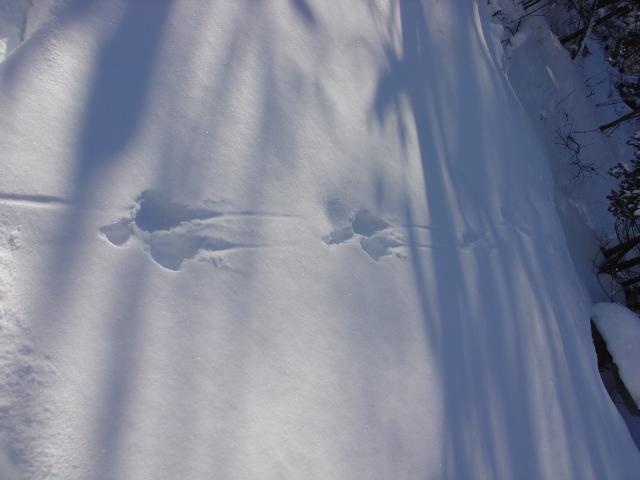
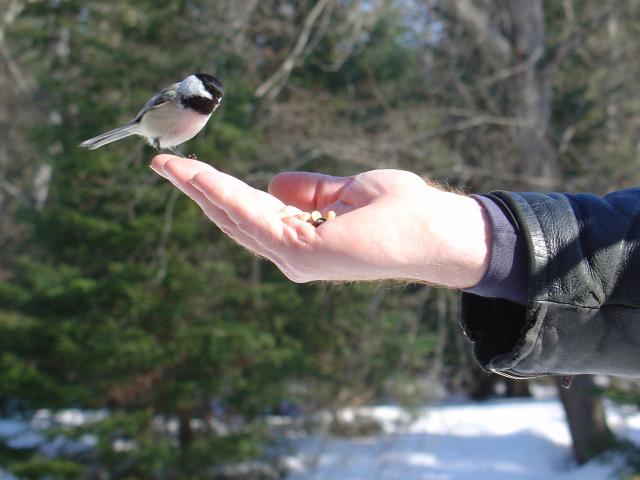
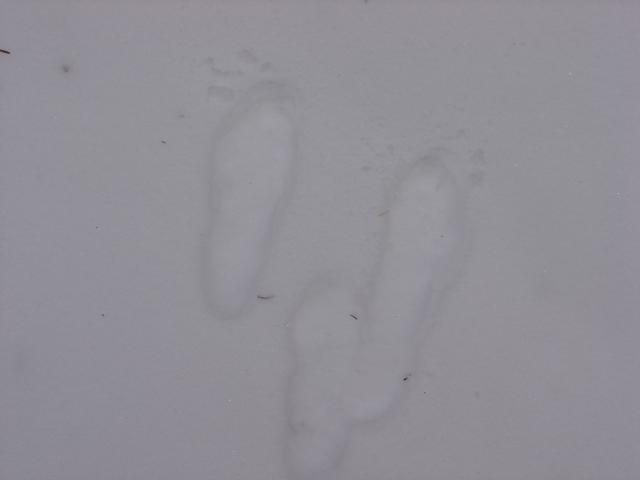
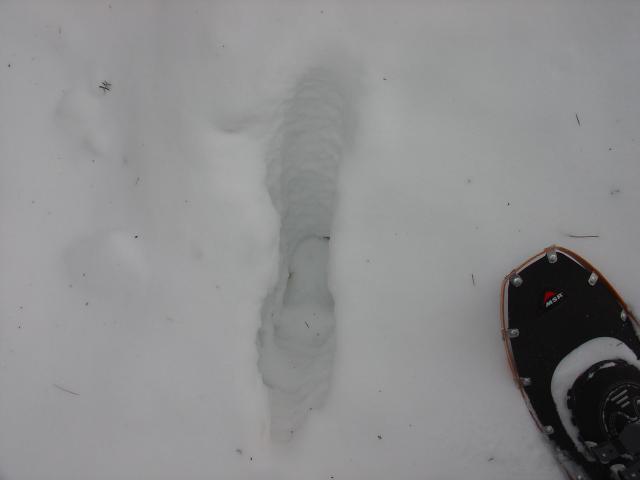
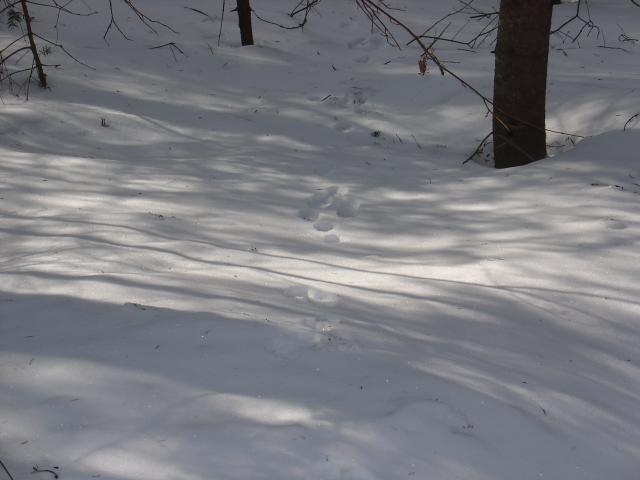

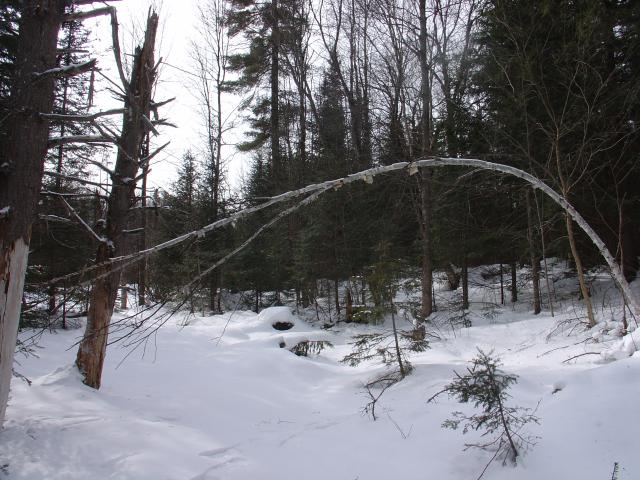
Staggered prints show the slow progress of a moose through deep crusty snow (above left). These large animals must take greater care moving about in winter conditions and typically lift their hooves out of such snow in stages (right). The cheerful chickadee has no such trouble getting about and groups are frequently encountered out in the forest. The chickadee's intelligent behavior is obvious and the hunger of a long cold winter quickly overcomes their fear of humans (below).

SPRING 2011
April 21
Arrived at the cabin 6 p.m., observed two large wild turkeys foraging at the side of the highway. Easter weekend featured a nice variety of bird life including the Yellow-bellied Sap Sucker and the Northern Flicker, repeated visits by a Pileated Woodpecker plus the steady drum of Ruffed Grouse beating their wings in the woods.
Most bizarre was the mating display of the male Wood Cock at night fall, a two part performance featuring a high circular flight path around the meadow (twittering all the way), followed by a head-over-heels plummet to earth and a series of sharp nasal calls from the yard... repeated numerous times!
Frog chorusing was first heard on April 24. It was a pleasant sunny day (defying the local weather forecast!) followed by near-freezing temperatures over night. Wood frogs, Spring Peepers and a few Gray Tree Frogs were just starting to call.
May...
... was a blur for me. In contrast to last year's dry Spring, we received above-average amounts of rain this year which resulted in an on-again/off-again start to the lawn care season. As soon as the sun would come out, the phone would start ringing and mowers would start selling. Over-grown lawns were in need of care and I gently dismantled a number of these yards in Toronto, as well as at the cabin in Bracebridge.
While toiling with the 16'' grass up at "the bog", I was entertained by the music of forest songbirds such as the veery and the white-throated sparrow. The NaturCut Classic HD was quietly mowing the cabin lawn as the sun beamed down. Dragonflies were now swarming to feast on the pesky bugs I'd stirred up with my reel mower. As dusk fell, the wood cock took up his nightly call to a background of chorusing of frogs and toads.
June 14, 2011
I met my artist friend David Parson at the cabin on Saturday, June 11. It was a damp, buggy day and Dave had arrived early and set up the screened gazebo. We did our best against the mosquitoes and were rewarded with a spectacular show by hundreds of fire flies in the back yard that night.
The next day we spooked a young deer on the forest path on our way down to the river to do some fishing. It was still damp and over-cast and the bugs were taking advantage of the calm weather -- fishing did not last long before we headed back to the cabin.
A group of about six cedar waxwings visited the yard briefly but they were driven away by the nesting robins. The robins have built their nest under the roof of our porch, a few short feet from a window, and are now very protective. They do seem to be adjusting to the infrequent visits by humans. In previous years, phoebes have nested in the same place and invariably end up abandoning the nest despite our best efforts to give them space.
June 14 was a glorious sunny day. My friend Dave had left and so, mostly, had the mosquitoes. He would never believe me, but it was an idyllic day with poplar leaves fluttering in the breeze and tiger swallowtail butterflies playfully drifting through the yard in search of late Spring flowers (top photo shows a Pearl Crescent butterfly feeding on the nectar of an orange hawkweed).
And finally, a congratulations must go out the the groundhog that lives under the metal shed -- at last count there were three young offspring venturing out from the burrow and into the yard.
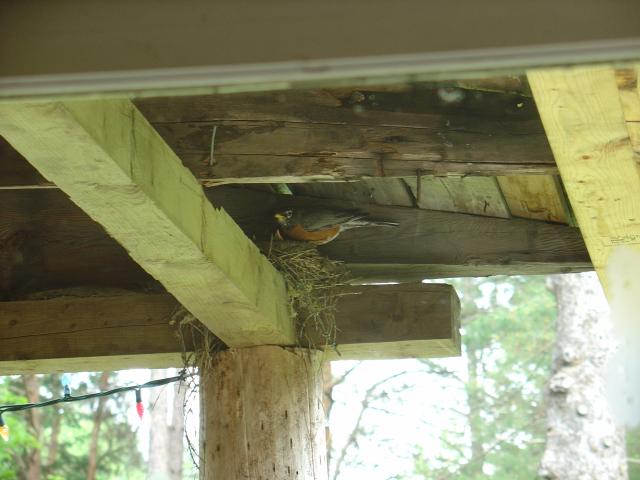
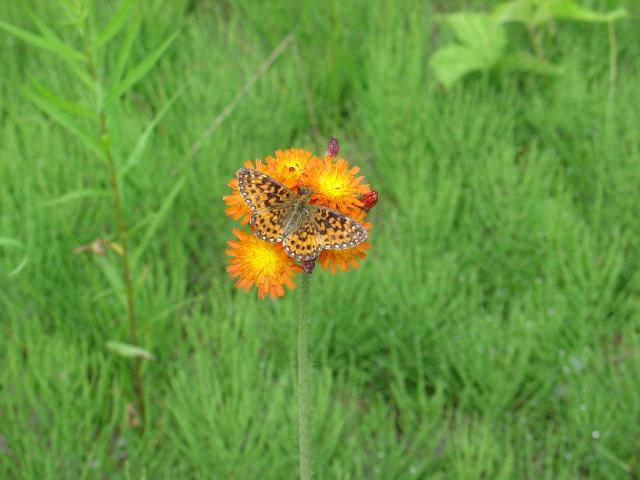

July 4, 2011
I spotted these beauties (photo at right) out in the meadow this morning. From up on the deck (sixty feet away) this lone flowering foxglove was none the less quite eye catching.
Up near the highway, the wild roses are having a banner year (below). Most of them are light pink in colour, with the odd darker blossom mixed in.
Warm
humid days followed by beautiful evenings with a chance of thunder --
ideal weather for the fireflies and other meadow insects that are
ramping up for the season. The overall weather pattern has reversed
itself from last year, with this year's wet spring being followed by
what appears to be a dry summer.
As
I was preparing to leave for Toronto after dinner on July 5, a small
group of wild turkeys entered the yard near the cabin. By the time I had
fished out the camera, they were nowhere to be seen!
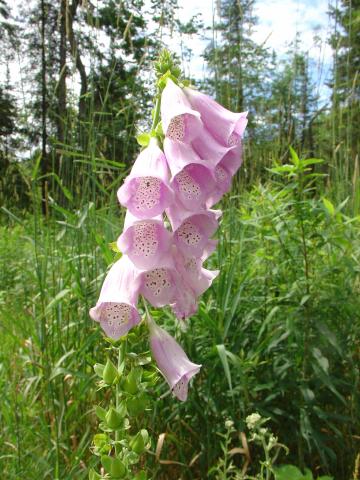
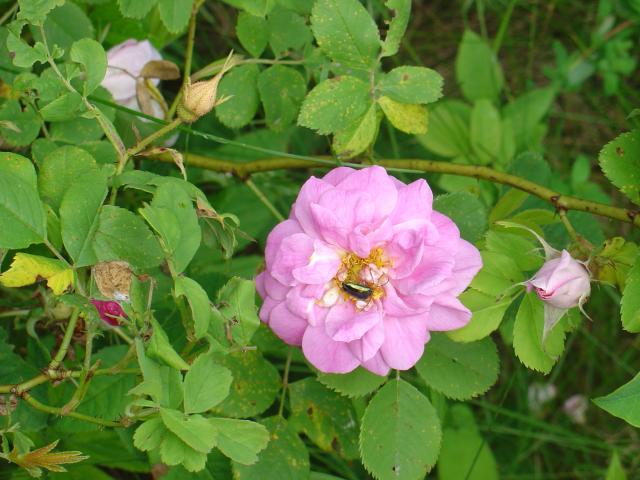
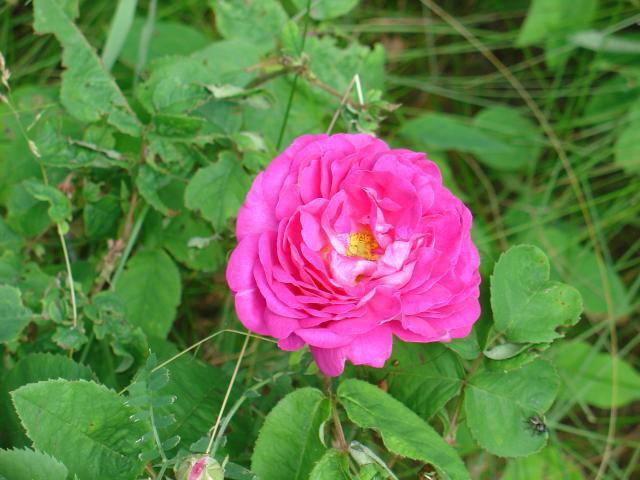
July 22, 2011
Enjoyed taking the Carnarvon route (Hwy. 35) home from the Black River today. The scenery was gorgeous as we are approaching the height of summer.
The dry conditions at the bog have not favoured a frog population explosion like last summer, although occasional thunder storms have at least kept the lawn green and healthy. In the yard many of the beautiful wild flowers have been displaced by rampantly invasive drought-resistant raspberry canes -- eventually I had to draw the line and do some overdue weeding to balance things out!
In Toronto things are even dryer, with most lawns the colour of straw. While this has greatly reduced the need to mow, a reel mower is still the friendliest way to tidy up a drought-stressed lawn by removing tall unsightly seed stems and other weeds that take energy from your turf. Be sure to adjust the mower to cut high so that the bulk of the grass blades are not removed.
August 6, 2011
Finally the summer rains have come! Hot humid days followed by thunder showers and heavy precipitation. There are now small frogs in the lawn and, as we approach the height of the season, the meadows have become a bug's paradise!

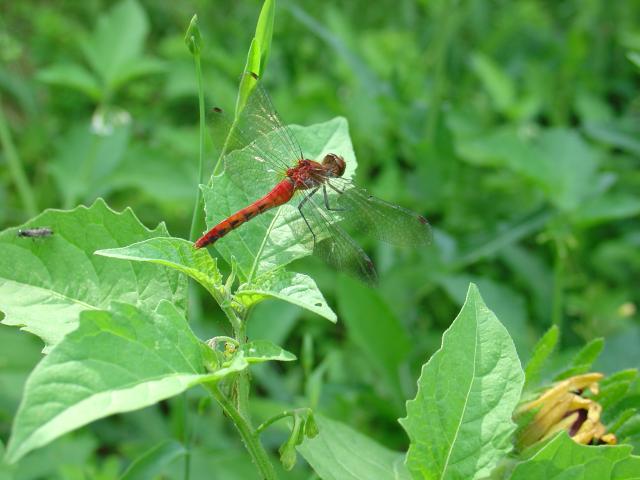
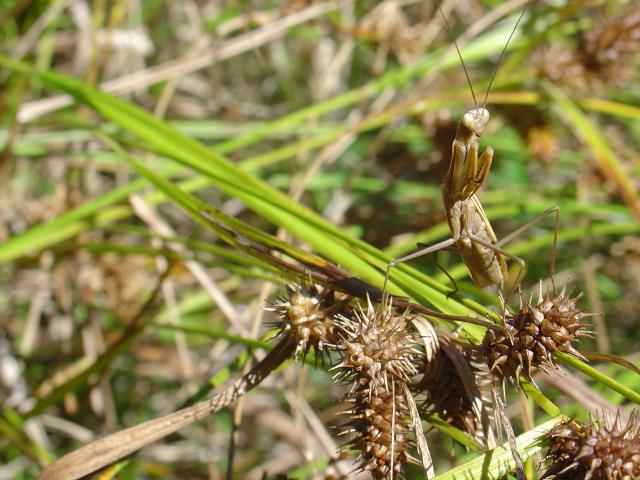
September 7-10, 2011
As summer winds down there are still many interesting creatures to be seen in the bog meadow. After 4 years of looking, I have finally observed Preying Mantises in the field; the photos below show a rare brown mantis and a Grey Tree Frog hidden in a black berry thicket.
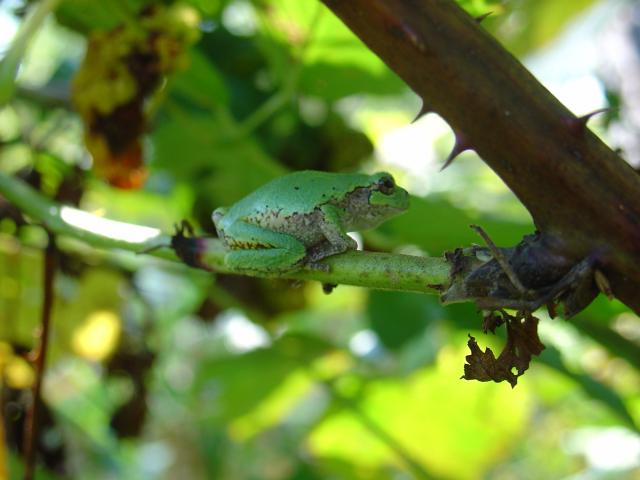
October 6-11, 2011
The days leading up to the Thanksgiving weekend saw sunny September-like conditions that were ideal for hiking around the bog.
Doriann enjoys the balmy weather while she checks out a craggy old maple. The tree is unusual in that the trunk's widest part is over twelve feet off the ground, the tangle of knots and other old wounds a testament to the rigors of life along the Black River.
At far right, I am amazed at how low the water level in the Black has gotten, no doubt a carry over from the dry hot summer we had.
A pleasant surprise for me was seeing Blue Birds for the first time ever! These rosy-breasted beauties visited our yard for a few sunny hours and were a delight to watch. Unfortunately, Doriann had not arrived with the camera yet but I am now motivated to put up Blue Bird nesting boxes for next year in the hopes attracting these rare visitors.
Another interesting encounter was with a Great Blue Heron out on the bog. I surprised this bird at close range -- and he surprised me by suddenly bursting into flight. He had been distracted by hundreds of tadpoles that were stranded in a small and drying pool (photos at right). This marshy area was fed by a nearby stream throughout the summer and was a magnet to green frogs in particular. As the vernal pool dried up it attracted a wide variety of small carnivores, all leaving their prints in the mud as they gorged on the helpless tadpoles.
